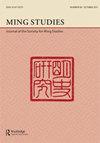Interview with Ming Scholars
IF 0.3
0 ASIAN STUDIES
引用次数: 0
Abstract
This is obviously something I’ve often been asked, so I wish I had a better answer. My education at school was focused on languages — including ancient ones — and history, and at some point in my teens these interests coalesced around China; I can recall entering a school art essay prize with a piece on the Song Huizong “Five-Coloured Parakeet” painting in the MFA Boston, which of course I had only seen in reproduction (I didn’t win). I was, perhaps somewhat weirdly, keen on “antiques” as a teenager and Chinese porcelain gripped me from early on, though this was a fairly indiscriminate interest and not particularly Ming-focused. I can however pinpoint the first book I read on the Ming in my teens, it was Vincent Cronin’s hagiography of Matteo Ricci, The Wise Man from the West, published in 1955. Studying Chinese at Cambridge as an undergraduate from 1972, neither the Ming nor art history were particularly present in my course. There was a minimal presence of art history near the beginning of my student years, in the form of lectures from the archaeologist Cheng Te-k’un 鄭德坤 (1908–2001), which I’m sorry to say I failed to find very engaging. Huang Zongxi 黃宗羲, Ming yi dai fang lu 明夷待訪錄 was one of our “set texts,” and I wrote my dissertation (a sort of “senior thesis”) based on a classic piece of 1960s Chinese scholarship; this was Wang Yuquan 王毓铨, Mingdai de juntun 明代的军屯, but this did not reflect a particular interest in the Ming. The topic was handed to me by Denis Twitchett (1925– 2006), the great historian of the Tang who was professor at Cambridge then; I think he just wanted a précis of a book he thought might be interesting to him, which is more or less all I did. The opportunity to study in Beijing in 1974–5 give me exposure to some Ming sites, particularly the Ming tombs, but at that time all sites like temples were closed to visitors, even if the first postCultural Revolution stirrings of intellectual life were just visible, and I bought then the copy of the Zhonghua shuju Ming shi which I still have. If anything, it was probably the Qing that really engaged me as a student, and my doctoral work was on a novel by the 19th century Mongol novelist Inǰannasi (1837– 1892). I had at that point ambitions to be a scholar of Chinese literature, of premodern fiction primarily. I was delighted (and very lucky) to join the curatorial staff of the Victoria and Albert Museum in 1979, but I seized on this more as a way of being paid to be interested in China, and if other opportunities had come good then my life would have been rather different. Ming Studies, 83, 67–80, May 2021明代学者访谈录
这显然是我经常被问到的问题,所以我希望我有一个更好的答案。我在学校所受的教育主要是语言——包括古代语言——和历史,在我十几岁的时候,这些兴趣在中国融合在一起;我记得我曾在波士顿美术学院(MFA Boston)以一幅关于宋徽宗《五色鹦鹉》的作品参加学校艺术论文奖,当然我只看过它的复制品(我没有获奖)。也许有点奇怪的是,我十几岁的时候就热衷于“古董”,中国瓷器从很早开始就吸引了我,尽管这是一个相当不加区分的兴趣,并不是特别关注明朝。然而,我能准确地说出我十几岁时读到的第一本关于明朝的书是文森特·克罗宁(Vincent Cronin) 1955年出版的利玛窦(Matteo Ricci)圣徒传《西方智者》(the Wise Man from the West)。1972年,我在剑桥大学读本科,学习中文,当时的课程中既没有明朝,也没有艺术史。在我刚开始读大学的时候,我很少接触到艺术史,那是考古学家郑德坤(1908-2001)的讲座,很遗憾,我觉得不太吸引人。《黄宗羲》是我们的“固定文本”之一,我的论文(一种“毕业论文”)是基于20世纪60年代中国学术的一篇经典作品;这是王玉泉毓铨,明代君吞,但这并没有反映出他对明朝的特别兴趣。这个题目是丹尼斯·特威切特(Denis Twitchett, 1925 - 2006)交给我的,他是伟大的唐朝历史学家,当时是剑桥大学的教授;我想他只是想要一本他觉得可能会感兴趣的书,我也差不多就是这么做的。1974年至1975年在北京学习的机会让我接触到了一些明朝遗址,尤其是明十三陵,但当时所有像寺庙这样的遗址都对游客关闭,即使文化大革命后知识分子生活的第一次骚动只是可见的,我当时买了《中华书居明史》的副本,我仍然拥有。如果说有什么不同的话,那可能是清朝真正吸引了我的学生时代,我的博士工作是研究19世纪蒙古小说家Inǰannasi(1837 - 1892)的一部小说。那时,我的理想是成为一名中国文学学者,主要是研究前现代小说。1979年,我很高兴(也很幸运)加入了维多利亚和阿尔伯特博物馆(Victoria and Albert Museum)的策展人员,但我更多地把它当作对中国感兴趣的一种赚钱方式,如果其他机会来的好,那么我的生活将会大不相同。明代研究,83,67-80,2021年5月
本文章由计算机程序翻译,如有差异,请以英文原文为准。
求助全文
约1分钟内获得全文
求助全文

 求助内容:
求助内容: 应助结果提醒方式:
应助结果提醒方式:


